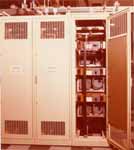X780 Protocol is an old IBM protocol used for batch processing applications,
and is supported over PSS via the Telenet TP3006 configured as RPAD (Telenet
use the term BPAD or X780 DSP PAD). This booklet describes:
1 the main elements of X780 protocol
2 the implementation RPAD uses to carry X780 over X25.
X780 RJE Protocol
X780 is carried over BISYNC lines and is used only in a point-to-point environment.
The host and terminal ends must 'bid' for the line, by sending an ENQ character.
The response should be an ACK0 if the other end will accept the bid.
HOST TERM
If both parties bid for the line at exactly the same time, then there is contention,
and the 'primary' end (previously defined) will retry after 1 second. If it
chooses not to do so, then the 'secondary' is free to bid after 3 seconds.
HOST (Designated primary) TERM (secondary)
Once a dialogue has been established, the end which has established the call
will send data in message blocks in a format recognised by the other end, the
data control using BISYNC. Refer to the booklet IBM-BSC.TXT for more details.
X780 is used mostly for batch processing applications, where there is signficantly more data traffic flowing in one direction than the other.
RPAD
carrying access an x.25 network The software for the host and terminal TP3006's is identical, and so the same
configuration is used on both ends. (BPAD and SPAD use different software configurations
for host and terminal).
Manual Connect
--------------
Manual Connect
The manual connect user establishes a virtual connection, by entering parameters
in the command mode.
All command mode directives must be made BEFORE message blocks are being transmitted
or AFTER the EOT.
The following commands are directed to the RPAD using manual-connect, are
not part of X780, and are not carried over PSS. They are all preceded by a '@'
character:
@CONN <sp><address> Make a call to specified
<sp><mnemonic address> NUA
@DISC Terminate call
@SET <parameter +><:><value> Set RPAD parameters
@SET? <parameter +><:><value> Set and read parameters
@PAR? <parameter +><,>------- Read parameters
Reverse Password
Host specific charge? required?
------------- ------------------------
@ID <sp><address> yes yes
@ID <sp><.><address> yes no
@ID <sp><;><address> no yes
@ID <sp><address></><name> yes no
@ID <sp><;><address></><name> no yes
@ID <sp><address></><name> yes yes
Non-host specific
-----------------
@ID <sp><name> no yes
@ID <sp><.><name> yes no
@ID <sp></><name> yes yes
@ID <sp><;><name> no yes
The @ID command does not support mnemonic addressing.
Auto-connect
------------
A user with the auto-connect option has access to only one DTE. The NUA of
the DTE is configured into the RPAD, and the connection is made when one end
bids for the line.
Auto-Connect
X25 Call Request Packet
=======================
When RPAD receives a line bid, it send a call request packet to the remote
end; the call user data field is configured as below:
Byte Bit
0 1 2 3 4 5 6 7
__________________________________________________________
0 | P R O T O C O L |
|----------------------------------------------------------|
1 | TERMINAL TYPE (3780, 2780, 2740, 2770, ?) |
|----------------------------------------------------------|
2 | S P A R E |
|----------------------------------------------------------|
3 | MAX BLOCK LENGTH | | ASCII/EBCDIC |L/E-E |
|--------------------------^-------------------------------
PRIMARY/SECONDARY
Once a call is accepted, a series of message blocks is transmitted in one
direction, whilst acknowledgements are sent in the other direction.
P S E B B
A T :::::: data :::::: T C C
D X X C C
RPAD checks the message for a bad BCC error, and if the message is good, strips
off the BCC and PAD (sync) characters before sending them in an information
packet. If the data block
is longer than the PSS pcket size then it is subdivided into smaller blocks,
and each of these is sent as an information packet with the M bit set. The following
examples illustrate how message blocks are modified and carried over PSS:
Local and End-to-End acknowledgements
=====================================
If a message block is terminated with ETB, it is acknowledged locally; (Note:
a message block terminated with ITB is not acknowledged, in accordance with
BSC protocol).
If it is terminated with ETX (either a single message or the last message
block or in a sequence of ETB or ITB-terminated message blocks) an end-to-end
acknowledgement is sent.
Error Handling
=============
RPAD follows the normal error handling procedures used in BSC on
the DTE to TP3 port.
The block-check characters are not required over PSS, because it
already features error correction. The remote RPAD reconstructs
the BCC, and reassembles the X780 message block for output to the
remote DTE.
1D}

